Predictive Intelligence: What You Need to Know


Key Takeaways:
Predictive intelligence transforms how organizations anticipate, prepare, and innovate by turning complex data into strategic foresight.
It reveals the trajectory of shifting consumer behaviors, risks, and trends, which makes it essential for organizational resilience and growth alike.
This guide outlines the key benefits of predictive intelligence and the technologies behind it.
Let’s jump right in.
Predictive intelligence combines historical, real-time, and contextual data to forecast what is most likely to happen in the future and generate actionable insights that guide agile, smart business decisions.
Predictive intelligence goes far beyond static reports or retrospective analysis.
It blends multiple streams of information to help organizations navigate uncertainty with confidence.
In other words, the central goal is to anticipate critical outcomes before they fully materialize, whether that’s a spike in customer demand, updates to regulatory requirements, or an operational bottleneck.
Accurate predictions, however, require continuously refreshed data inputs.
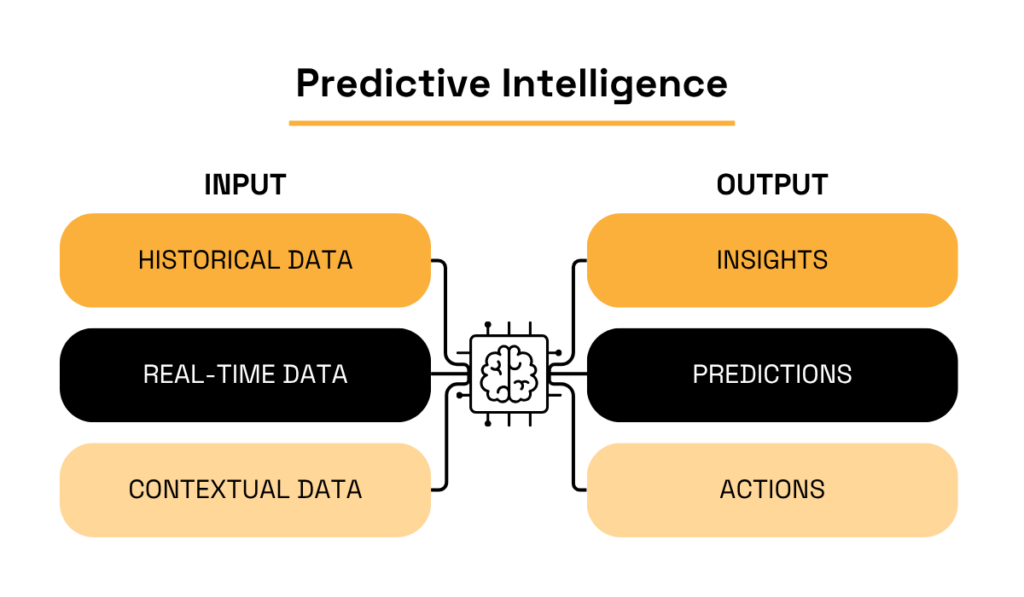
Source: Veridion
As seen in the illustration above, organizations typically draw on three complementary categories of data:
| Historical data | Helps establish patterns based on past transactions, customer behavior, or operational performance. |
| Real-time data | Delivers live inputs such as sensor readings, social media activity, or market fluctuations. |
| Contextual data | Assesses external factors, including economic conditions, regulatory shifts, or even weather disruptions. |
Together, these datasets form the raw material for predictive algorithms with wide-ranging applications.
Predictive intelligence supports demand forecasting, asset reliability monitoring, and early detection of compliance risks.
In supply chain management, for example, it helps enterprises anticipate disruptions caused by material shortages, logistics delays, or severe weather.
Its relevance extends beyond operations.
When it comes to customer-facing functions, predictive intelligence enables organizations to respond to fast-changing expectations.
As Neby Ejigu, Senior Partner of Digital Transformation at FINN Partners, notes, awareness of future scenarios means little if these insights don’t translate to palpable value today.
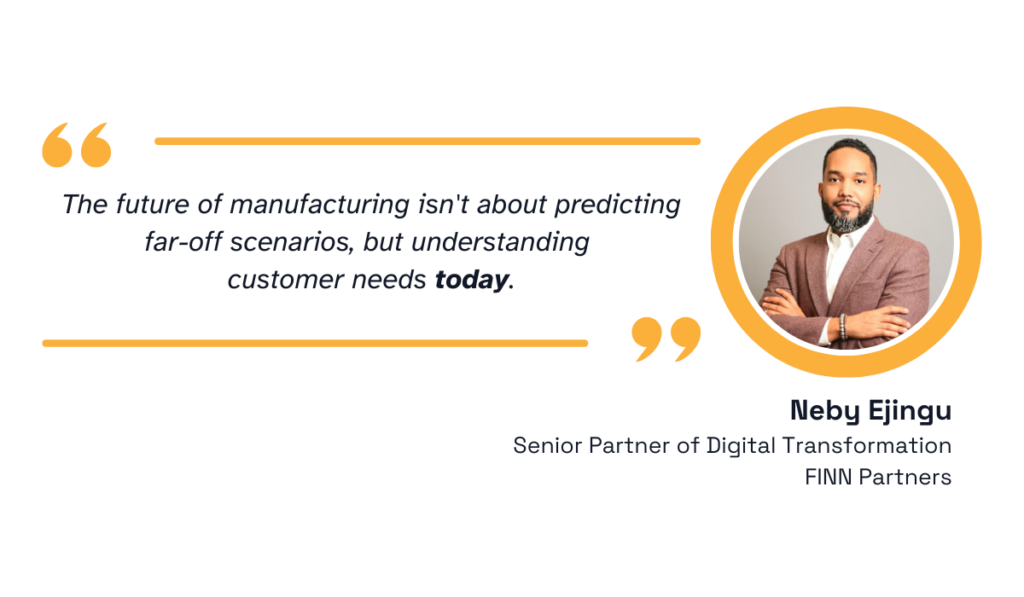
Illustration: Veridion / Quote: LinkedIn
This perspective is equally applicable across multiple industries and business functions.
To sum up, predictive intelligence transforms uncertainty into foresight.
Merging diverse datasets with advanced analytics enables organizations to move from reactive responses to proactive strategies.
Predictive intelligence enables you to identify patterns, anticipate behaviors, forecast trends, and more.
The potential business and strategic value is enormous, with the following sections exploring three of its most critical benefits.
Predictive intelligence enables organizations to identify potential risks, such as financial instability, cybersecurity threats, or supply chain disruptions, before they fully materialize.
With risk today more dynamic than ever, spotting early warning signals and taking preventive action is essential for businesses.
Third-party reliance is a clear example.
According to Prevalent’s 2024 research, 86% of corporations have third-party risk management (TPRM) programs in place.
Yet monitoring practices vary widely, leaving plenty of gaps.
Cybersecurity is the only area where most organizations favor continuous monitoring feeds (75%) over questionnaire-based assessments (61%).
By contrast, only 22% use monitoring feeds for ESG risk tracking, and 44% don’t track it at all.
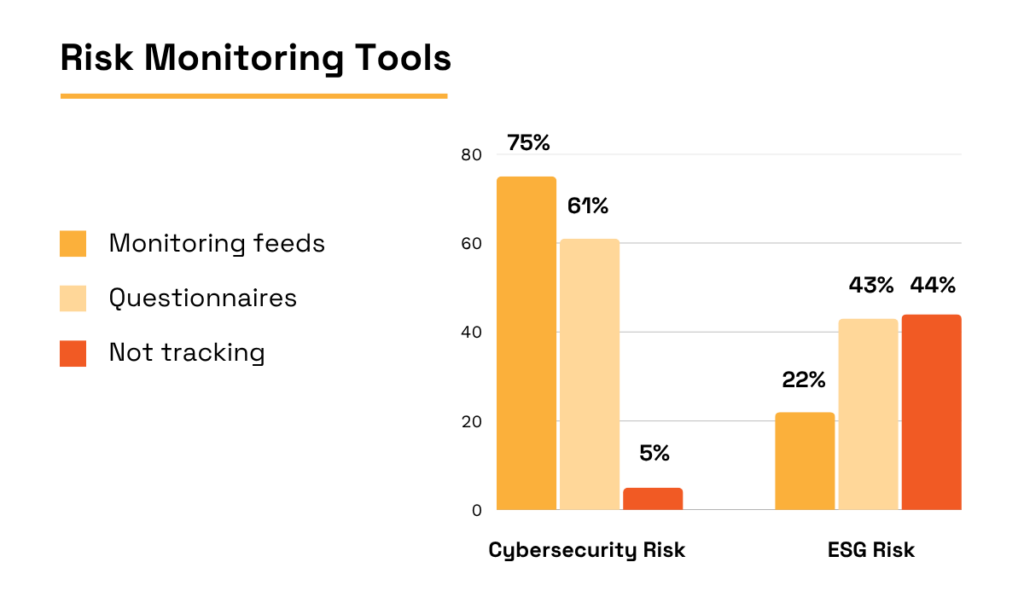
Illustration: Veridion / Data: Prevalent
That’s an alarmingly low percentage considering the risks involved.
Predictive intelligence helps close this gap by extending real-time monitoring across all risk domains, not just security.
Take extreme-weather events as an example.
Dataminr’s Brian Gumbel warns that, beyond physical damages to integral supply chain facilities, these events can also trigger digital crises.
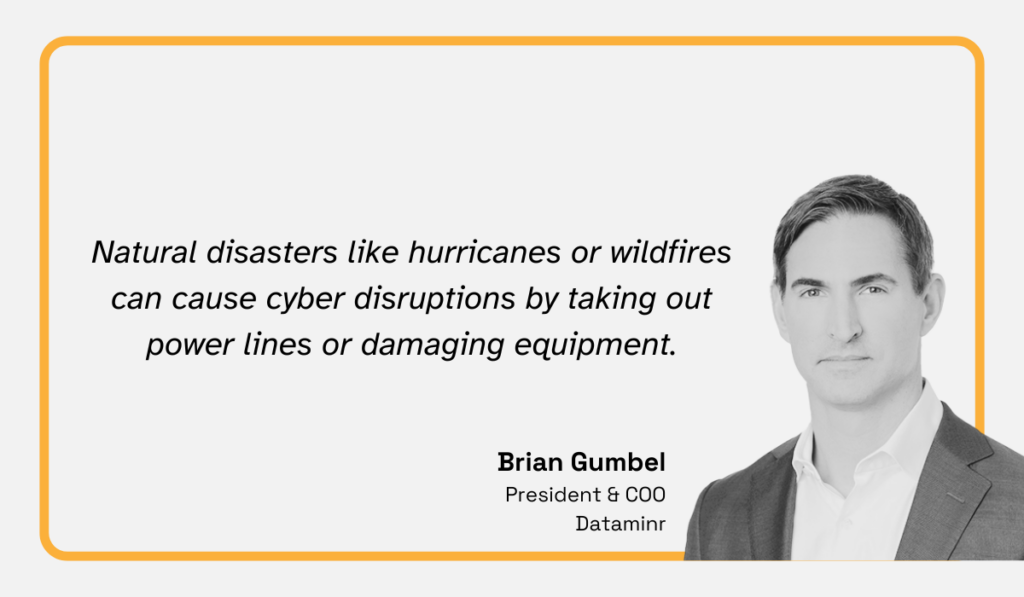
Illustration: Veridion / Quote: Big Think
In Gumbel’s words, if one flooded data center can bring down entire businesses, there’s an urgent need to find ways to mitigate the impact of such events.
Predictive intelligence tools are excellent at catching indicators of where the greatest risks are.
For instance, Veridion’s AI-powered analysis overlaid climate hazard maps with 67,000+ supply chain sites and revealed that nearly 5% of the UK’s essential infrastructure is directly exposed to intensifying weather risks.
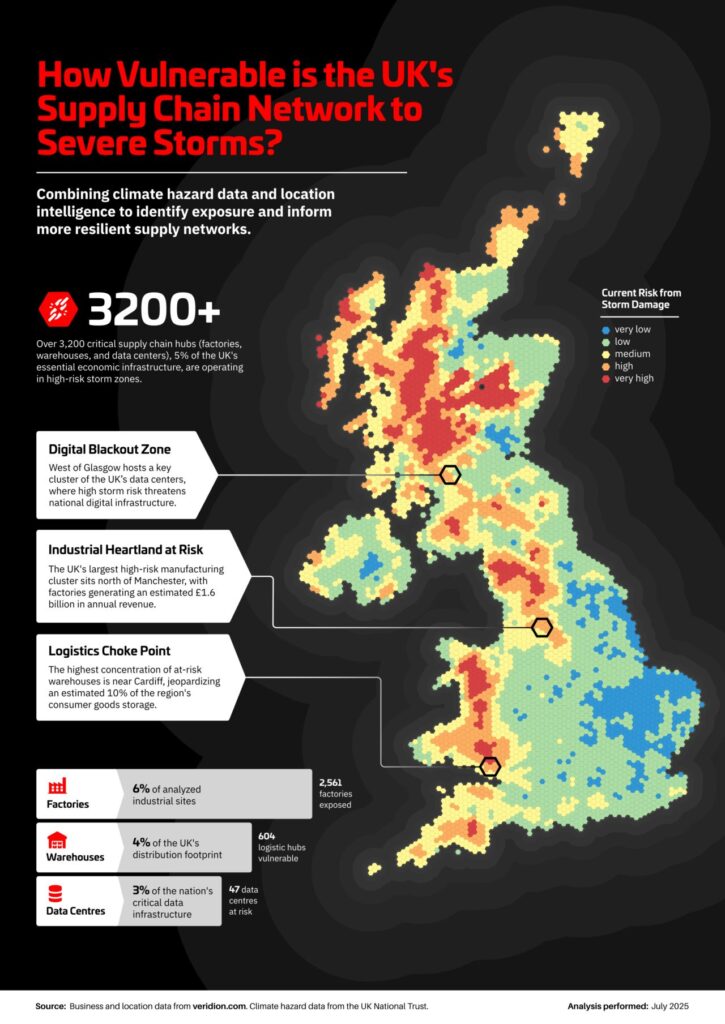
Source: Veridion on LinkedIn
Insights like these enable leaders to strengthen contingency planning, from relocating vulnerable facilities and diversifying suppliers to reinforcing digital infrastructure.
In short, predictive intelligence turns risk from an unforeseen disruption into a more manageable variable.
Ultimately, this helps organizations identify, quantify, and address threats before they escalate into crises.
Predictive models give organizations the ability to see beyond the present, forecasting market trends, customer behaviors, and competitor strategies.
This forward-looking perspective is a big reason why 82.2% of Fortune 1000 companies are increasing investment in data and analytics, as per Wavestone’s recent survey.
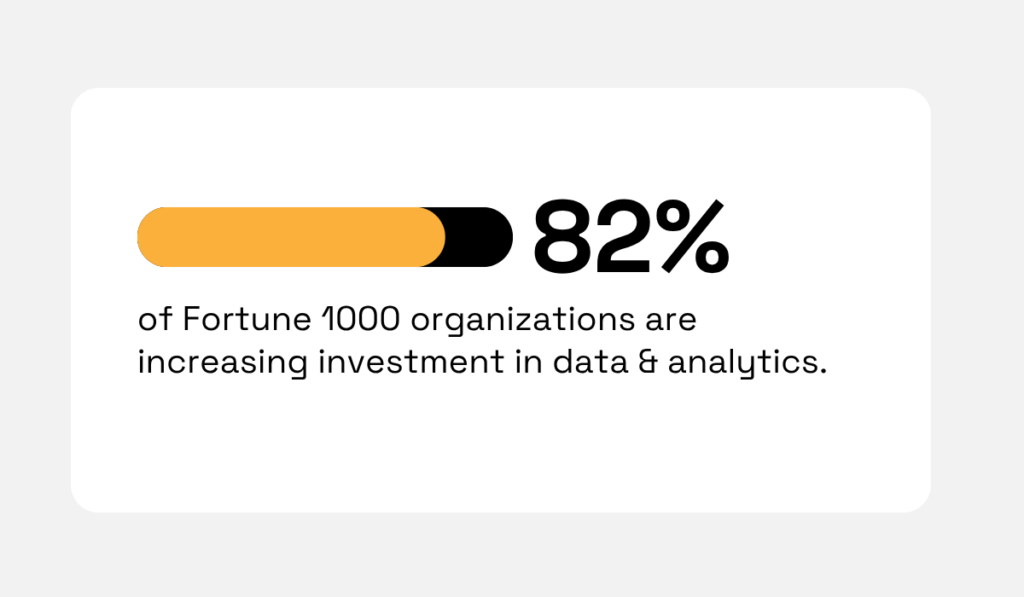
Illustration: Veridion / Data: Wavestone
The rationale is clear: predictive intelligence equips leaders with the insights needed to align resources, investments, and initiatives with future risks and opportunities.
For example, by combining weather models, macroeconomic indicators, agricultural yield data, and even social sentiment analytics, businesses can anticipate demand fluctuations weeks in advance.
In practice, that can mean the difference between an industry leader who replenishes beverage stock ahead of a heatwave and a competitor left scrambling amid shortages and price spikes.
This agility is especially vital in volatile trade environments.
With tariff shifts reshaping global markets, more companies are embracing predictive intelligence tools.
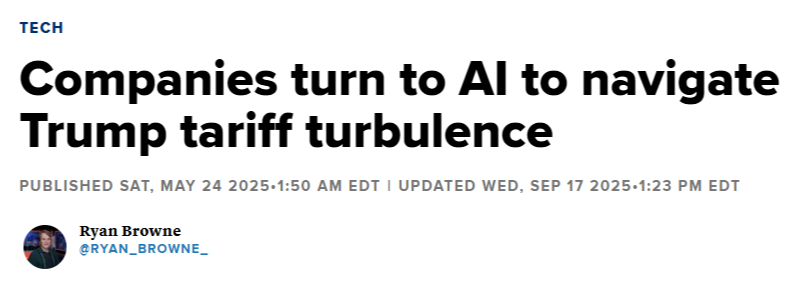
Source: CNBC
Previously, smaller teams of in-house experts might have been enough to keep pace, but this is no longer the case.
According to Eric Loeb, executive VP of government affairs at Salesforce, navigating changes to tariff systems manually is no longer an option.
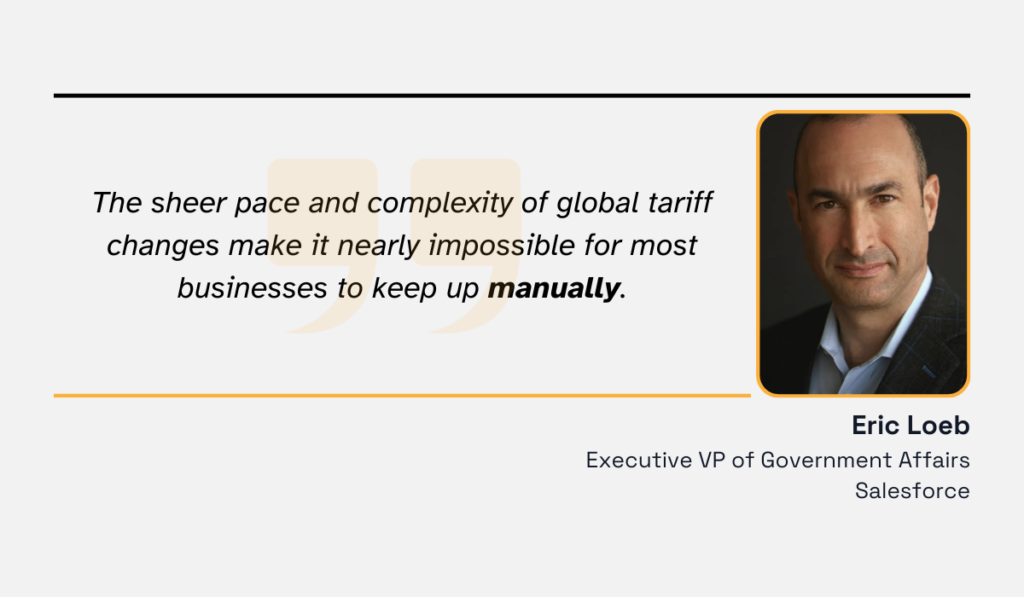
Illustration: Veridion / Quote: CNBC
What’s worse, such volatility won’t be a short-term concern, which means that relying on outdated approaches puts you at risk of being blindsided by sudden regulatory or trade disruptions.
The good news?
Predictive models enable you to prepare in advance, testing outcomes, assessing impacts, and pivoting well before new rules take effect.
Still, preparing for external shocks is only half the story.
Organizations must also adapt their internal processes to remain resilient.
Fortunately, predictive intelligence supports this transformation, too, as demonstrated by Deloitte’s procurement operations.
While at Deloitte, Maureen Odum, now Data Intelligence Manager at the UK Ministry of Defence, developed a predictive tool focusing on vendor cycle delays.
The insights didn’t just improve procurement, but also became the basis for redesigning the entire lead-time strategy.
The result?
The tool helped guide key decisions, ultimately saving Deloitte ₦3.6 billion (around $8.8 million) in just three months.
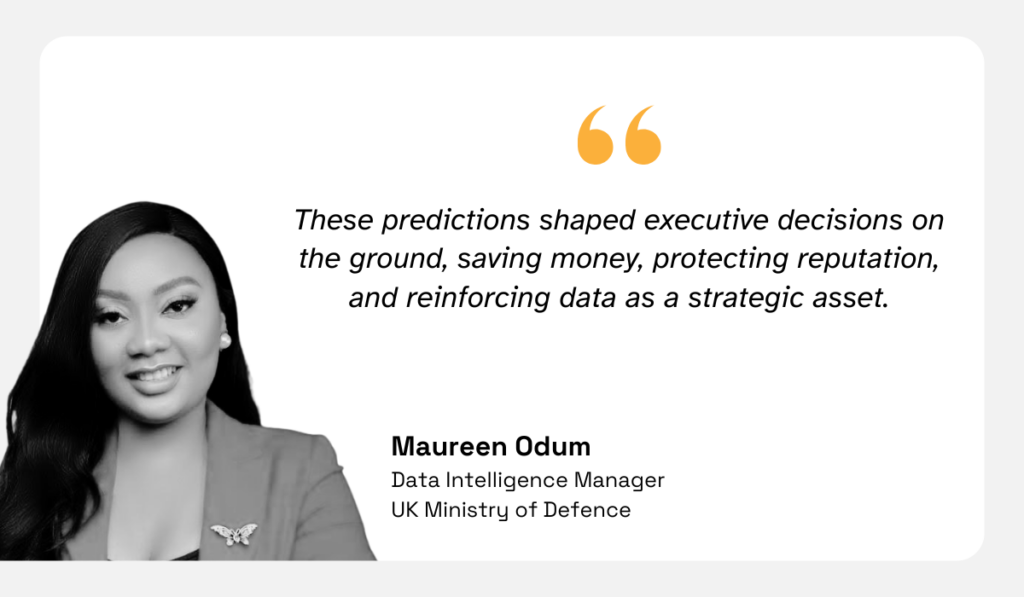
Illustration: Veridion / Quote: This Day Live
But, as Odum emphasizes, predictive intelligence offers more than the immediate financial impact.
When decisions become proactive and aligned with future possibilities, we’re talking about long-term strategic value.
By uncovering hidden patterns and forecasting future trends, predictive intelligence fuels innovation.
From product design to service delivery, organizations can leverage foresight to build offerings that meet tomorrow’s needs, rather than simply reacting to what’s already evident today and offered by competitors.
Recent research underscores this point.
Crayon’s 2022 report found that 98% of business stakeholders view competitive insights as essential to success.
Meanwhile, Wavestone’s 2024 survey shows a similar trend, with 77.6% of organizations already using analytics to launch new business initiatives.
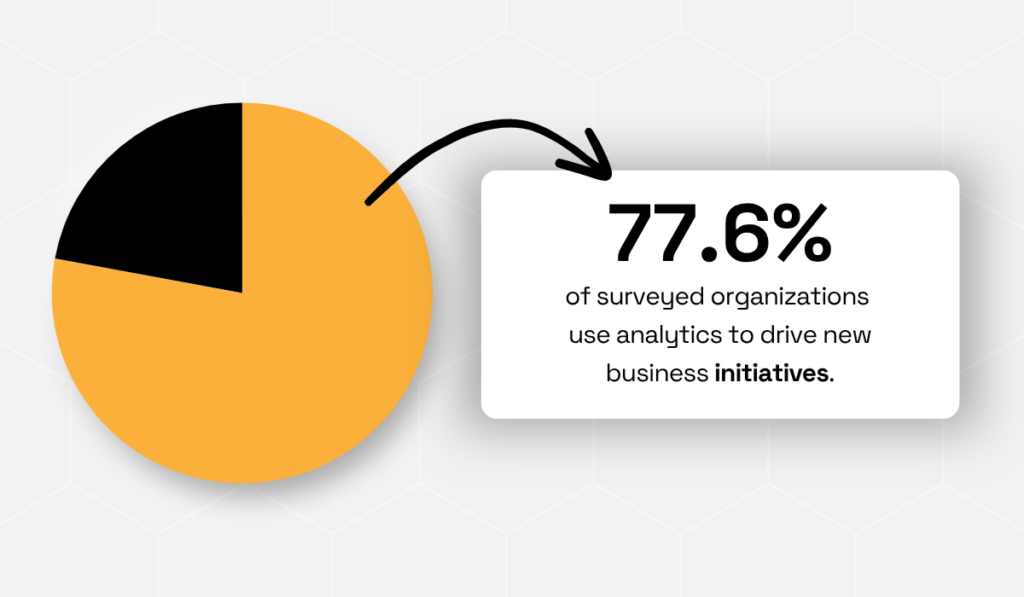
Illustration: Veridion / Data: Wavestone
Predictive intelligence combines these strengths, transforming competitive insights and analytics into actionable foresight.
It helps businesses spot unmet customer needs and emerging opportunities, propelling efforts toward innovation.
As Baiju Shah, former CSO of Accenture Song and now CEO of AKQA, puts it, the ability to anticipate what customers will want next has become central to growth.
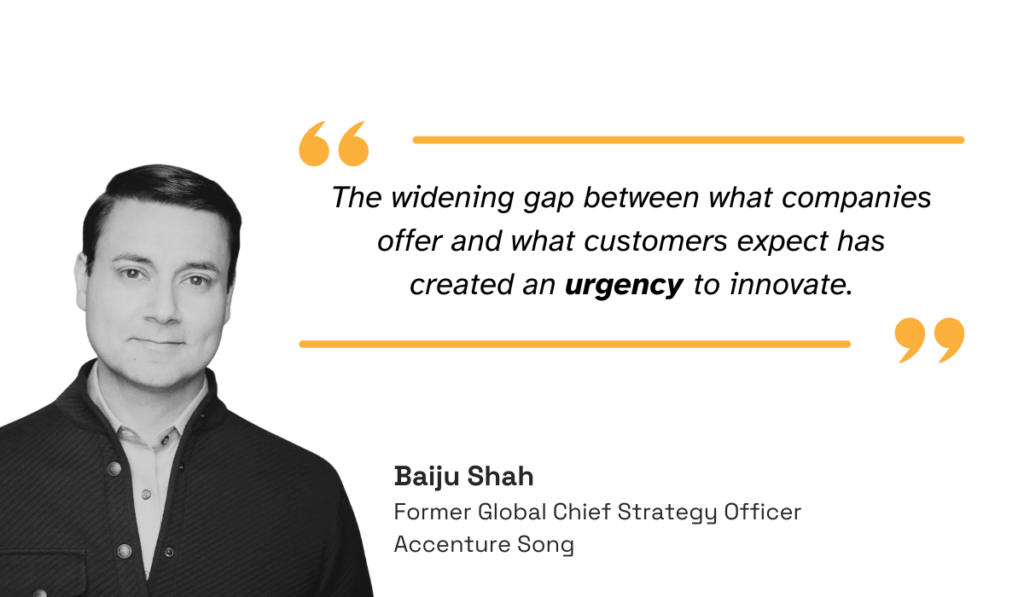
Illustration: Veridion / Quote: Accenture
And that’s precisely where predictive intelligence comes in.
Forecasts made by predictive models influence pricing, product mix, channel strategies, and even supply chain adjustments, speeding up innovation cycles across industries.
One of the clearest examples comes from the pharmaceutical industry.
During the COVID-19 pandemic, predictive analytics played a critical role in vaccine development.
Instead of merely storing and searching through vast amounts of clinical data, Pfizer began applying advanced data mining and predictive modeling across the entire drug-development cycle.
According to former VP and Head of Information Management Boris Braylan, this shift now allows Pfizer to calculate trial outcomes faster and prioritize the most promising candidates.
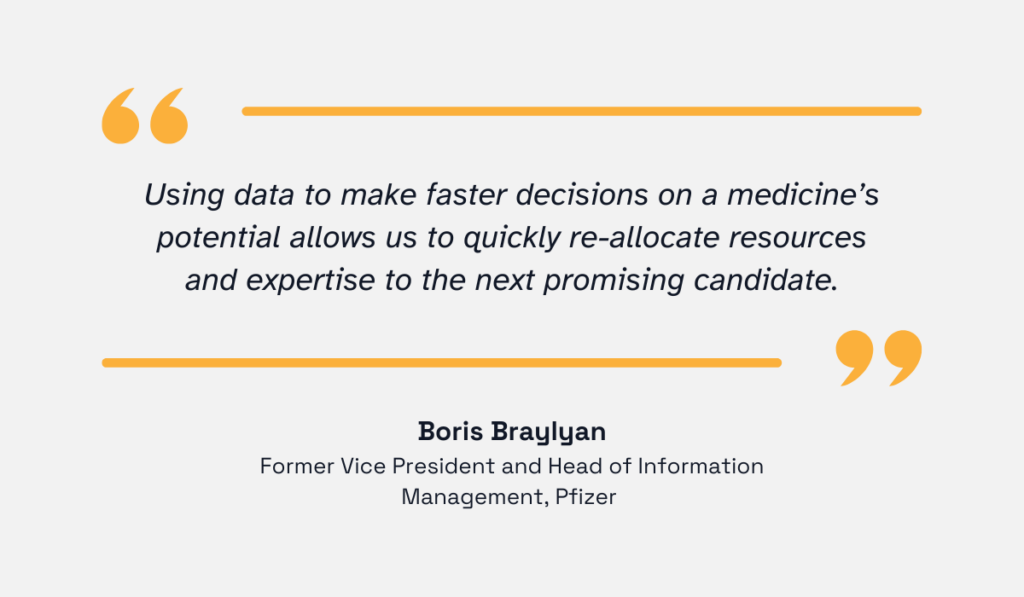
Illustration: Veridion / Quote: Pfizer
The approach didn’t stop after the pandemic.
Pfizer has since invested in an AI/ML platform with generative capabilities, projecting that it could boost product yield by roughly 10% and reduce cycle times by around 25%.
Looking forward, the company also intends to use predictive intelligence to anticipate regulatory queries, enabling teams to prepare responses in advance and shorten approval timelines.
Together, these advancements show how predictive intelligence converts data to drive innovation, accelerating processes, reducing uncertainty, and empowering organizations.
Predictive intelligence is powered by a set of interrelated technologies. Some provide scale, others interpret meaning, while some automate decisions.
Here’s a quick overview of how they all fit together.
Machine learning (ML) is the backbone of predictive intelligence.
Its algorithms uncover patterns in massive datasets, detect correlations humans might overlook, and continuously refine predictions as new data flows in.
This ability transforms static data into dynamic foresight, moving from situational awareness to future-state prediction.
Veridion’s expansive global database of structured company data is one example.
By applying ML across more than 130 million businesses, the platform delivers near real-time insights without sacrificing depth of detail.
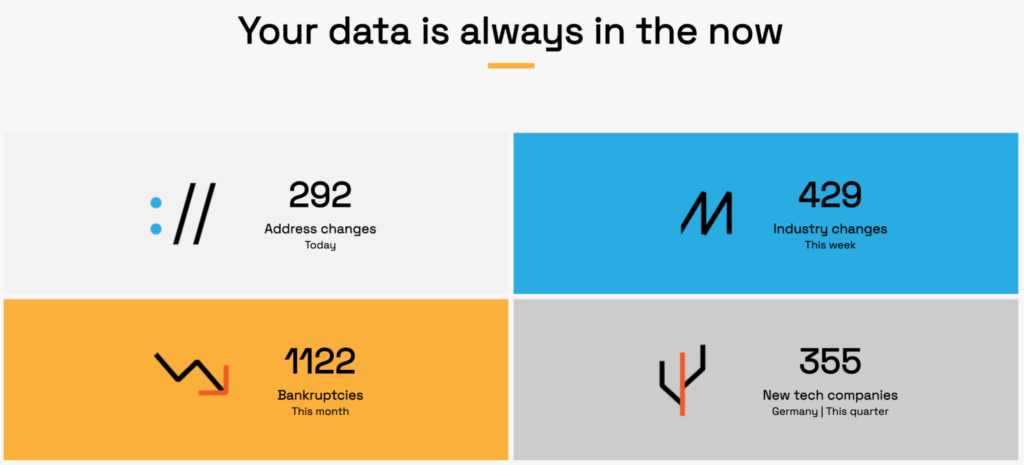
Source: Veridion
Veridion’s models analyze over 220 attributes per company—including ESG metrics, certifications, and product-level data—to map markets, highlight supply risks, and surface strategic exposure.
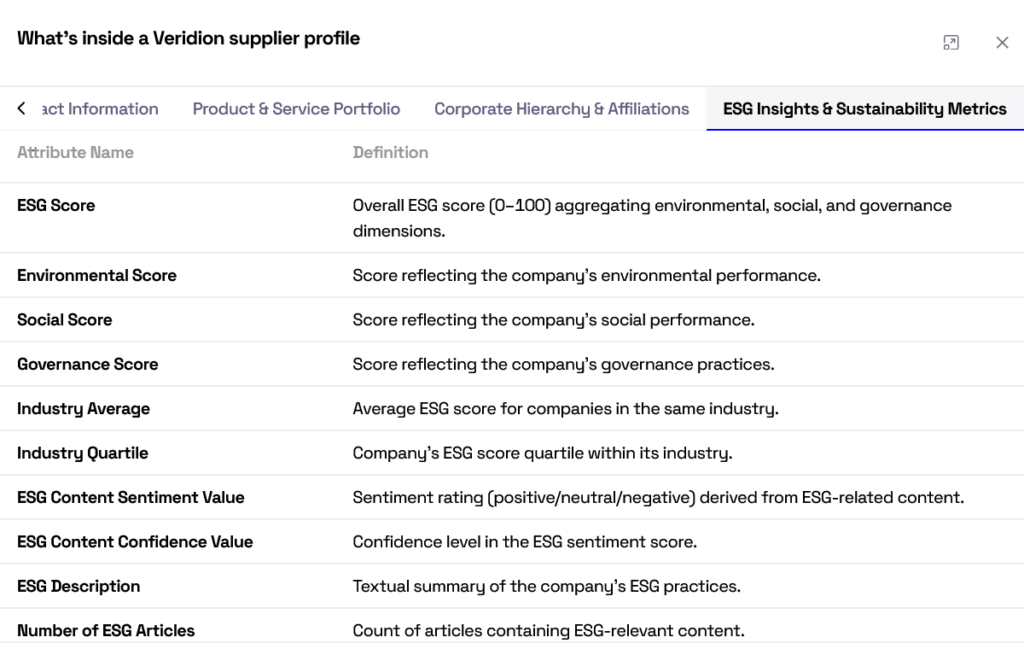
Source: Veridion
The use cases are wide-ranging: faster supplier discovery, more agile TPRM, and fresher, more accurate market intelligence.
In short, machine learning gives you the ability to connect disparate data points.
And with complex datasets turned into actionable predictions, organizations are in a better position to anticipate disruptions and seize emerging opportunities.
Artificial intelligence helps extend predictive intelligence beyond pattern recognition by automating analysis and even suggesting or initiating actions.
Thanks to its iterative nature, key processes like data collection, preprocessing, and hypothesis formulation improve continually, yielding stronger outputs over time.

Source: Nature
Let’s consider the tariff volatility we mentioned earlier.
Going through a 4,000-plus page customs document by hand would take hundreds of hours and still leave plenty of room for error.
Salesforce addressed this by developing an import specialist AI agent capable of instantly processing updates across 20,000 product categories.
Rather than offering generic guidance, it calculates duties and freight costs, projects the impact of tariff or pricing changes, and recommends adjustments tailored to each company’s position.
Salesforce Executive VP, Paul Tatum, neatly summarizes these capabilities:
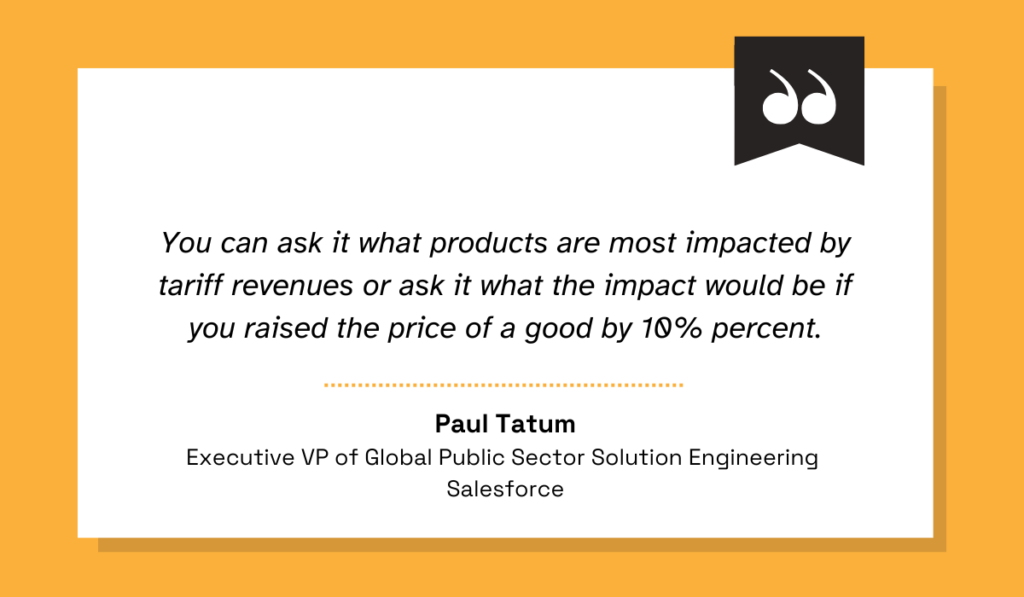
Illustration: Veridion / Quote: Salesforce
In practice, this means AI agents can not only identify trends but also forecast impacts and trigger responses in line with predicted outcomes.
Another essential technology is natural language processing, which enables predictive systems to comb through and interpret unstructured text, be it news stories, social media chatter, vendor reports, or disclosures.
Much of today’s risk information resides in language rather than structured fields, and NLP is what makes this accessible by operating on a similar, iterative basis.
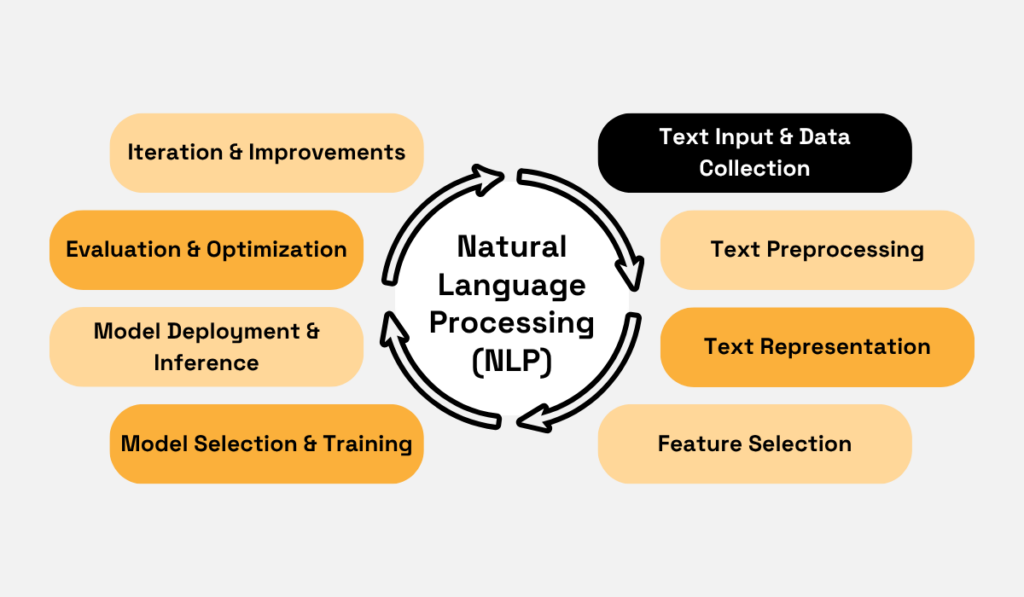
Source: Veridion
For example, NLP can detect a supplier’s deteriorating reputation on social media well before performance metrics reveal a problem.
It can also flag early warnings of geopolitical instability, regulatory changes, or cyber incidents by analyzing real-time text feeds.
In a sense, NLP acts as the bridge between noisy language signals and structured foresight, transforming raw text into early warnings you can actually take action on.
Finally, we have big data analytics tools that provide the scale required to integrate structured and unstructured data, simulate outcomes, and model scenarios with precision.
All the predictive capabilities depend on this key foundation: the ability to process vast, complex datasets.
Big data analytics enable organizations to store, process, and mine datasets efficiently, uncovering insights that would otherwise stay buried.
Dataminr provides a case in point.
Its immense event archive, spanning more than 15 years, documents how historical events unfolded over time.
By training on this data, its AI platform can anticipate the trajectories of emerging developments in real time.
On a practical level, this can translate to visualizing the effects of hazardous weather on employees, helping organizations prepare and respond proactively.
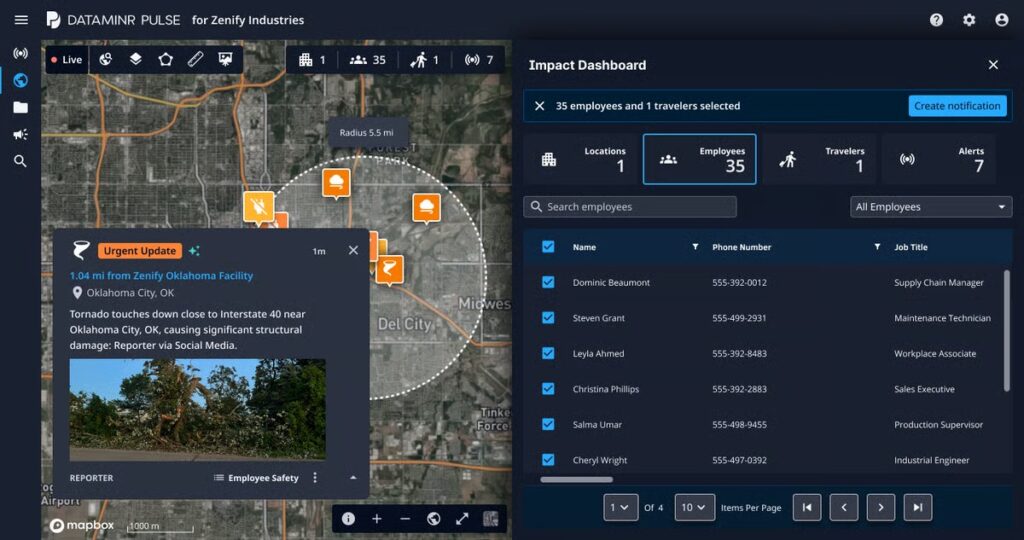
Source: G2
In conclusion, big data analytics turns raw information into a strategic resource, giving predictive systems the depth and breadth needed to contextualize risks and opportunities.
Predictive intelligence isn’t a passing trend, but a major strategic shift.
Its key advantage lies in transforming data into all kinds of actionable foresight, informing risk management, strategic decision-making, innovation, and more.
In other words, by harnessing machine learning, AI analytics, NLP, and big data, organizations turn uncertainty into opportunity.
The next step for leaders is clear: embed predictive intelligence into your core operations.
It’s the best way to future-proof your business and leave your competitors in the dust.